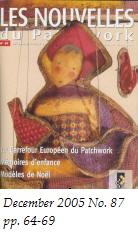 It
has been my pleasure to work with Isabelle and Christiane, who requested the use
of baby and doll quilts from my personal collection for this article. For more
about Christiane as a quilter in France, who's come to love antique American
quilts, see her bio. Above, she stands in front of
a quilt called, Prairie Flowers. Her friends made it, using a quilt from the
Metropolitan Museum collections in New York for the design. It
has been my pleasure to work with Isabelle and Christiane, who requested the use
of baby and doll quilts from my personal collection for this article. For more
about Christiane as a quilter in France, who's come to love antique American
quilts, see her bio. Above, she stands in front of
a quilt called, Prairie Flowers. Her friends made it, using a quilt from the
Metropolitan Museum collections in New York for the design.
I want to thank Isabelle Etienne-Bugnot, editor of the magazine, for the
translation of the article into English.
They have supplied the photos, unless otherwise noted.
Please visit the
French quilting guild website:
www.francepatchwork.com
Emotions like tenderness or nostalgia overwhelm us when we discover the
little quilts - doll or baby quilts - made for, and sometimes by, the American
children.
The first baby and crib quilts
We do not know exactly when the first of these small quilts was made. By the end
of the 17th century, baby coverlets were mentioned for the first time in the New
England archives - diaries, inventories stored in museums, libraries and
historical.JPG) societies. Around 1750, cribs, rocking cradles and small beds wheels were listed
in inventories. It is supposed that the making of small quilts goes with the
existence of small beds especially made for children… Until the middle of the
19th century, children very often slept in their parents’ beds or even in the
servant’s bed. In 1841, in a book named The American Woman’s Home,
Catharine Beecher wrote the following warning: “The baby shall not sleep in his
mothers’ arms at night except when the weather is very cold. A crib near his
mother, a good warmth and a light cover are the best conditions for a good
sleep.”
societies. Around 1750, cribs, rocking cradles and small beds wheels were listed
in inventories. It is supposed that the making of small quilts goes with the
existence of small beds especially made for children… Until the middle of the
19th century, children very often slept in their parents’ beds or even in the
servant’s bed. In 1841, in a book named The American Woman’s Home,
Catharine Beecher wrote the following warning: “The baby shall not sleep in his
mothers’ arms at night except when the weather is very cold. A crib near his
mother, a good warmth and a light cover are the best conditions for a good
sleep.”
When they grew a little older, children slept in beds that were pushed under the
parents’ bed during the daytime, so that there was more space in the room. The
nursery as a r.JPG) oom
especially intended for children appeared toward 1875, in Victorian times. oom
especially intended for children appeared toward 1875, in Victorian times.
Wrapping up the babies to protect them from the cold might be at the origin of
these little quilts. Many of them were square (43” x 43”) or sometimes
rectangular (47” x 31”). They might have been cut or inspired by the woven wool
or silk blankets English Puritans, emigrating to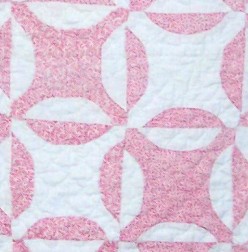 America, presenting the newborn for baptism would warm them in after they had
been immersed in the cold water.
America, presenting the newborn for baptism would warm them in after they had
been immersed in the cold water.
c. 1880, child's quilt, Robbing Peter to Pay Paul pattern, two double-pink
prints with white, Kimberly Wulfert Collection
Antique baby quilts are real treasures
These pieces are rare. In the 19th century, the pregnant mother or a
grandmother would usually sew a quilt for the first-born child, a quilt often
washed… And then for the babies coming one after the other in a short period of
time, the same quilt would be used for all of them until it was worn-out and
thrown away.
Until 1875, the infant mortality rate was very high. The lifeless baby was often
wrapped up in a little quilt before he was placed in his coffin.
.jpg) Then
where do the exceptional pieces, in very good condition, which can be found in
American museums and in private collections, come from? Here are a few answers: Then
where do the exceptional pieces, in very good condition, which can be found in
American museums and in private collections, come from? Here are a few answers:
- In the well-off families, some quilts
had been used very little because the mother owned several baby quilts.
- We can mention the example of a little
quilt dated 1880 given to Fanny Wike, of Shafferstown, Pennsylvania, by her
aunts, for her trousseau. Fanny never had children and the quilt remained as
new.
- Perhaps women made such little quilts
for pleasure because they were quickly finished, but they did not intend to
use them or maybe they served as a sample before taking up a very large
work.
How styles of these little quilts evolved
throughout the 19th century is related to the “place” children occupied within
the family.
1941 embroidered child's quilt, signed by
the grandmothers and relatives for a new baby,
Kimberly Wulfert collection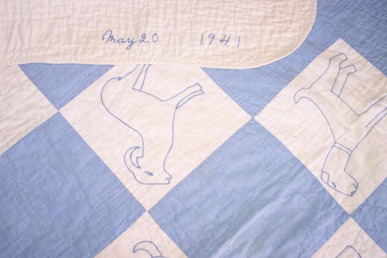
- In the 18th century and during the
three quarters of the following century, God, Home, Country were the
three words encompassed a woman’s life . By giving birth to numerous
children, the woman fulfilled her duties toward God (according to the
Scriptures), toward her Home (because the children provide the labor
necessary for prosperity of the family’s activities, being most often
agricultural) and towards her Land (by increasing the number of
citizens). But women were afraid of pregnancies and difficult childbirths.
They were scared about the loss of a child, and each new child meant more
work for them. On Sunday, November 25, 1855, Ellen Birdseye Wheaton wearily
noted in her diary the birth of her twelfth child: “Another little girl was
added to our number… It was a great trial to me to have another child, so
that, at times, I was very much unreconciled to it, but I don’t doubt we
shall love her, as much as we have any of the others”. (The Art of
Independence, Elizabeth Donaghy Garrett).
Very quickly in large families, as soon as the child was no longer an
infant, he was considered a miniature adult, with responsibilities and
chores to do according to his age. He went to school when there was not too
much work to do at home. He was dressed like an adult. It seemed then quite
logical to make baby quilts identical to the adult quilts, with the same
fabrics, colors and patterns. The only difference was the size of the quilts
and patterns. These were miniature quilts.
The evolution in quilt styles followed through in baby quilt styles: whole
cloth chintz, broderie perse, medallions, hexagons, appliqués, pieced
quilts, log cabins and patriotic quilts. The exceptionally well-executed
pieces are real historic archives thanks to their fabrics and patterns.
Their value is almost incalculable
- Gradually the attitude of adults
towards children began to change. In families well off, the children
portraits were painted along with flowers, animals or toys. In the last
quarter of the 19th century, books especially written for the children began
to appear: nursery rhymes, fairy tales, adventure stories, and history of
the land. Handkerchiefs were printed with motifs of animals, boats, everyday
life scenes or child game scenes. The children were then considered as
children and no more as adults in miniature. A whole new world began to
arise around them.
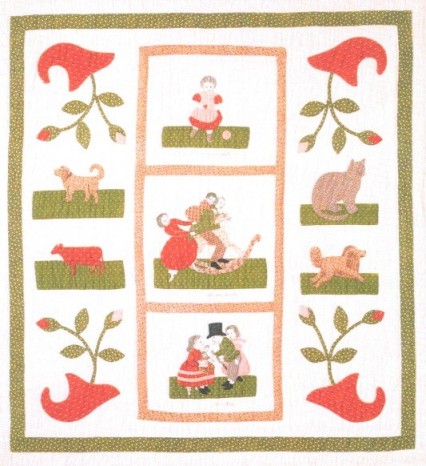
c. 1872, Scenes of Childhood crib quilt, New York; appliquéd and embroidered;
Shelburne Museum Collection, reprinted with their permission
At that time, little quilts reflected the
interests specific to the children. The appliqués that they were often made
represented animals, building blocks with letters, Noah’s ark stories, and
scenes from a
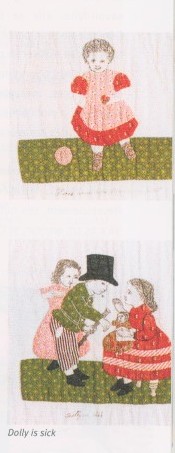 circus,
puppets or games. Patterns were published in magazines. For example, the quilt
from the Shelburne Museum collection, Scenes of Childhood Crib Quilt
(circa 1872), describes childhood scenes. One of them at the bottom of the
quilt, saying, “Dolly is sick”, seems to have been inspired by a picture
published in Peterson’s Magazine in April 1872. The same scene has been
found on a printed handkerchief. The child quilt, therefore, had an educational
function of stimulating the imagination and by helping one to learn the
alphabet, numbers or identify animals. circus,
puppets or games. Patterns were published in magazines. For example, the quilt
from the Shelburne Museum collection, Scenes of Childhood Crib Quilt
(circa 1872), describes childhood scenes. One of them at the bottom of the
quilt, saying, “Dolly is sick”, seems to have been inspired by a picture
published in Peterson’s Magazine in April 1872. The same scene has been
found on a printed handkerchief. The child quilt, therefore, had an educational
function of stimulating the imagination and by helping one to learn the
alphabet, numbers or identify animals.
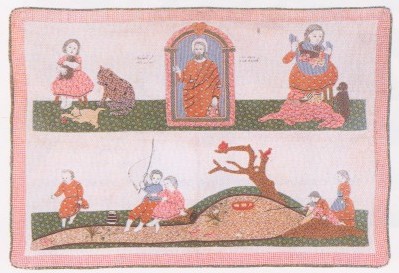
Pillow Cover made by same maker as the quilt.
First, the famous characters, Sunbonnet
Sue and Overall Bill, were embroidered in red or blue. Around 1910,
patterns of these appliqués became available (see Katie’s quilt).
At the beginning of the 20th century, fabric motifs as well as patterns and kits
especially designed for children began to appear. For example, one can mention
the bunnies, a pattern which was proposed by Marie D. Webster in 1914.
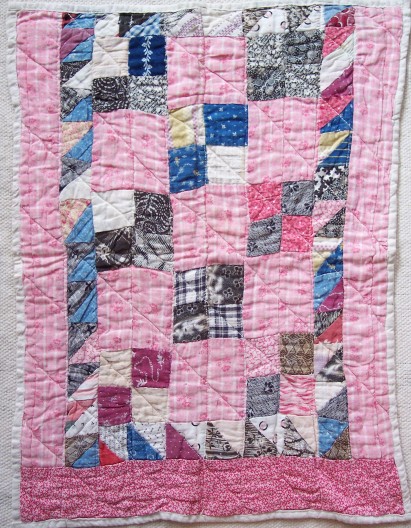
In the 19th century, in America, it was essential that a woman could sew,
whatever her social class. She had to sew the household linen and most often
clothes, a know-how that had to be taught to her daughters. Generally, the
little girl began to learn these skills at the age of three, and making a doll
quilt was certainly the most attractive way to begin… she had to choose fabrics
from the scrap bag, and then measure, cut and sew with small and regular
stitches a simple pattern like the four patch, nine patch or hexagons. And
during a short time, often half an hour, the little girl had to make a piece of
work… while sitting beside her mother or grandmother. Fortunately, these quilts
were often small (20” x 20” or 14” x 10”) and therefore rather quickly
completed.
circa 1900, doll's quilt, made by a child; hand-pieced,
machine quilted;
Kimberly Wulfert collection
Sewing for one’s doll was very stimulating:
the little girl imitated her mother’s behavior with babies. The doll was part of
the girl’s education. In rural classes, dolls were often very simple objects and
were made by the mother or the grandmother. Remember Charlotte, Laura Ingalls
Wilder’s doll (Little House on the Prairie, book 2: On the Banks of Plum
Creek, chapter 29): “Her red thread mouth and her boot-button eyes were
smiling. Laura lifted her up gently, smoothed her waving hair made of black
thread and took the pleats out of her skirts. As Charlotte was a rag doll, she
had no feet and her hands were simply sewn to the flat end of her arms. But Laura loved her so much.” Very nice American, French or German dolls could
also be found. They were dressed like adults.
But Laura loved her so much.” Very nice American, French or German dolls could
also be found. They were dressed like adults.
Sewing a first doll quilt made the little girls very proud of themselves and
many of them enjoyed sewing larger pieces. Some others, having encountered
difficulties in making their first doll quilt, would never reconcile with
sewing. In 1889, Lucy Larcom wrote about her childhood. As a small child,
walking behind her father on the way to church, she looked up at him and
thought: “How tall he is. And how long his coat looks. And how many thousands
and thousands stitches there must be in his coat and pantaloons? And I suppose I
have got to grow up and have a husband, and put all those little stitches in his
coat and pantaloons. Oh, I never, never can do it.” She never married. (Shelburne,
Vermont, The Shelburne Museum, page 19, 1957)
Circa 1930, feedsack fabric sampler, machine pieced and quilted, doll-size;
Kimberly Wulfert collection
Sometimes, the doll quilt was a present
sewn by a grown-up: it was then less naïve and less clumsy…
These little quilts were so full of emotions and sentiments: messages of hope
for the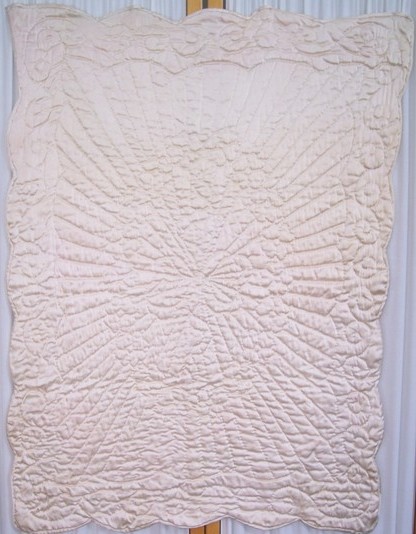 expecting mothers, messages of love for the babies, or for the little girl who
was given a doll quilt, or for the doll… All these quilts tell us the story of
childhood, and so we can better understand why these little pieces are dearly
coveted by collectors and historians.
expecting mothers, messages of love for the babies, or for the little girl who
was given a doll quilt, or for the doll… All these quilts tell us the story of
childhood, and so we can better understand why these little pieces are dearly
coveted by collectors and historians.
Bibliography
Baby, crib and doll quilts
Pat Long and Dennis Duke - America’s glorious quilts - Duke and Harding
Small Endearments - nineteenth-century quilts for children and dolls
Sandi Fox – Rutledge Hill Press
Pieces of the Past
Nancy J. Martin – That Patchwork Place
Quilts américains
Robert Bishop – Dessain et Tolra
| 1920 - 1940, satin pram
(buggy) quilt, could have been quilted by a professional, purchased
by the owner, but there is no label; pale pink on one side, pale
yellow on other; edges are scalloped, hand-quilted |
The Arts of Independence
Elisabeth Donaghy Garrett – The National Society, Daughters of the American
Revolution
American doll quilts
Kathleen Tracy – That Patchwork Place
Classic crib quilts and how to make them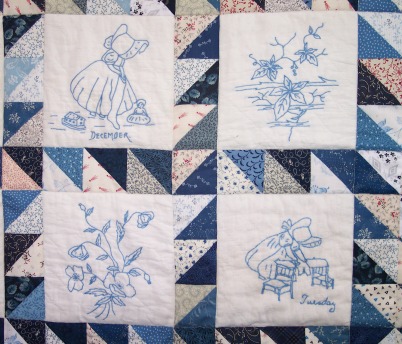
Thos. K. Woodard and Blanche Greenstein – Dover Publications, INC.
Art of the Needle
Henry Joyce – Shelburne Museum (Scenes of Childhood quilt scanned from
this book, pg 52-53, with permission from Shelburne Museum)
Treasure or Not ? How to compare and value American Quilts
Stella Rubin – Miller’s
Quilts – Their story and how to make them
Marie D. Webster – Practical Patchwork
|
"Katie's Quilt" circa 1900 bluework blocks,
child's quilt, made in 2004 by Kimberly Wulfert Pattern
for: Katie's quilt |
The American Quilt: A History of Cloth
and Comfort 1750-1950
Roderick Kiracofe and Mary Elizabeth Johson
Reflections on fashion dolls and the art of growing up
Deborah E. Kraak and Barbara C. Abrams
| Behind Christiane is a
quilt made by her friends, from the book, Un trésor perdu et
retrouvé, by Sophie Campbell. |
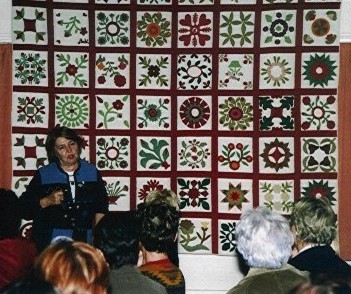
* Christane'
Billard's Bio
Christiane was a qualified teacher in
biology and geology. She has written scientific school books for students.
Mother of three boys, her life was full and she had not much time left for
handicrafts she loved so much.
In 1972, she discovered quilts and quilting in magazines. A little later, she
met two American ladies, Diane de Obaldia, owner of the quilting store Le
Rouvray in Paris, and Sophie Campbell: Sophie is the teacher who introduced
quilting in France and taught to the first French women interested in that new
craft. In 1987, Christiane made her first trip to the East Coast of the United
States and soon, she met the quilt collector Patricia Smith and bought her first
antique quilt, a grandmother's garden. Two days later, she had the opportunity
to visit in private the exhibition "Homage to Amanda". Seeing, understanding and
placing antique quilts in their history became a passion for Christiane.
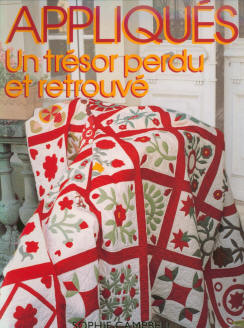 She
was at that time very close to Sophie Campbell who knew so well "how to make
quilts talk". With her, Christiane learned how to date the quilts, to know the
fabrics. She wrote the French text for Sophie's book: "Un trésor perdu et
retrouvé" (1995). She
was at that time very close to Sophie Campbell who knew so well "how to make
quilts talk". With her, Christiane learned how to date the quilts, to know the
fabrics. She wrote the French text for Sophie's book: "Un trésor perdu et
retrouvé" (1995).
She went back to the United States several times and visited wonderful museums:
Metropolitan Museum, Folk Art Museum, Newark Museum, DAR Museum (her favorite!),
American History Museum, Renwick Gallery, Textile Museum in Washington, Lowell
Museum, Williamsburg Museum in Virginia. Each time, she came back filled with
wonder!
She also had the opportunity to meet Kathryn Berenson, Betsey Telford, Patricia
Cox, Nancy Martin, Marsha McCloskey, Pat Nichols… She would love to meet
Kimberly Wulfert one day. She reads many articles about antique quilts and now
she can make traditional quilts with the reproduction fabrics available.
She hopes she can soon go back to the U.S. because there are so many more
museums to visit …
Easy to make and very cute doll quilt
patterns based on old quilts can be downloaded for free from America’s Quilting
History:
http://www.womenfolk.com/baby_quilts/ |